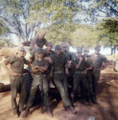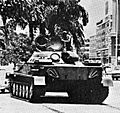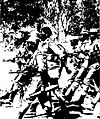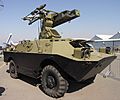South African Border War facts for kids
Quick facts for kids South African Border War |
|||||||
|---|---|---|---|---|---|---|---|
 Clockwise from top left: FAPLA MiG-21bis on an airstrip; FAPLA or Cuban T-62 tank captured by the SADF; 1981 protests against SADF aggression in Angola; Soviet advisor with FAPLA subordinates; G6 howitzers just prior to their deployment to Cuito Cuanavale; South African expeditionary troops in the operational area |
|||||||
|
|||||||
| Belligerents | |||||||
| 1966–1974: |
1966–1974: |
||||||
| 1975–1990: |
1975–1990: |
||||||
| Casualties and losses | |||||||
The South African Border War refers to the conflict that took place from 1966 to 1990 primarily in South-West Africa (now Namibia) between South Africa on one side and the South-West Africa People's Organisation (SWAPO) and its allies on the other.
The roots of the conflict can be traced back to World War I, when South Africa invaded and conquered the colony of German South-West Africa on behalf of the British Empire and the other Allies of World War I. In the aftermath of the German defeat, the League of Nations awarded South Africa a mandate to administer the territory until its inhabitants were ready to govern themselves.
Following World War II, South Africa refused to surrender South-West Africa to a proposed United Nations Trusteeship agreement and instead requested the right to annex it as a fifth province. Steps were taken to integrate South-West Africa into South Africa, including giving the local white population the right to elect representatives to the Parliament of South Africa.
In 1962, SWAPO was formed to resist South African rule and petition for South-West African independence. With support from the Soviet Union, SWAPO began training guerrillas and from 1966 onwards frequently clashed with the South African police and army. The war entered a new phase in 1975, when Angola gained independence and its new communist government began providing support to the guerrillas. South African troops launched raids into Angola to destroy SWAPO bases, which led to battles with the Angolan army. Cuba, which had sent troops to bolster the Angolan government, was directly involved in some of these battles.
In 1988, South Africa, Angola, and Cuba signed a Tripartite Accord committing them to peace. Cuba agreed to withdraw from Angola if South Africa withdrew from South-West Africa and granted that territory independence. South-West Africa gained independence as Namibia in early 1990.
Images for kids
-
Sam Nujoma, founder and leader of SWAPO and its OPO predecessor.
-
Equipment of Soviet origin supplied to SWAPO. From left to right: satchel, Dragunov sniper rifle, PG-7V RPG projectile, and RPG-7 launcher.
-
South African armoured column in Ohangwena, 1970s. Convoys of vehicles like these were the primary target for PLAN ambushes and mines.
See also
 In Spanish: Guerra de la frontera de Sudáfrica para niños
In Spanish: Guerra de la frontera de Sudáfrica para niños





















